| Karkee Web Home Page | Pattern 1958 Home Page | Patt. '58 Components Page |
Web Equipment, Pattern 1958 - Equipment & Equipment Carriers
Other Carriers
Stores Ref. CN 0028 CARRIER, CAPE, MK. 1
Stores Ref. CN 8465-99-973-6219 CARRIER, CAPE
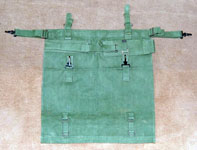
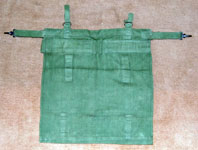
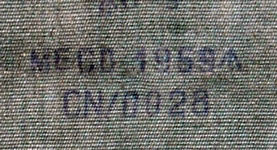 This was a plain square of webbing, designed as a “wrapper”, for the Cape / Groundsheet, with items stitched to its outside face. Levered snap hooks, on short chapes served to attach the Carrier to the Waist belt. In front of these, on the left, a semi pocket open on its top and inward side was stitched. On the right side a tapered long pocket was stitched in line with the opposite pocket. The head of the Lightweight pick fitted into this arrangement and was held in place by a strap across the gap between the pockets. The strap was stitched to the tapered pocket, with the link and tabs of a QR fastener, whose staple was located on the semi-pocket. The long open edge of the latter was further secured with a short strap and buckle, the buckle terminating in a crimped-on tip. On the edge adjacent to the Head carrier were QR tabs, which fastened to one of two staples mounted on the opposite edge of the Carrier. Completing the fittings, a horizontal and adjustable strap was stitched to each side of the Carrier. These carried a levered snap hook, which engaged with the loops on the rear edges of each Pouch. Tightened up, they pulled in the Cape carrier tight over the buttocks and also pulled the Ammunition pouches back slightly.
This was a plain square of webbing, designed as a “wrapper”, for the Cape / Groundsheet, with items stitched to its outside face. Levered snap hooks, on short chapes served to attach the Carrier to the Waist belt. In front of these, on the left, a semi pocket open on its top and inward side was stitched. On the right side a tapered long pocket was stitched in line with the opposite pocket. The head of the Lightweight pick fitted into this arrangement and was held in place by a strap across the gap between the pockets. The strap was stitched to the tapered pocket, with the link and tabs of a QR fastener, whose staple was located on the semi-pocket. The long open edge of the latter was further secured with a short strap and buckle, the buckle terminating in a crimped-on tip. On the edge adjacent to the Head carrier were QR tabs, which fastened to one of two staples mounted on the opposite edge of the Carrier. Completing the fittings, a horizontal and adjustable strap was stitched to each side of the Carrier. These carried a levered snap hook, which engaged with the loops on the rear edges of each Pouch. Tightened up, they pulled in the Cape carrier tight over the buttocks and also pulled the Ammunition pouches back slightly.
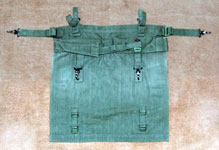
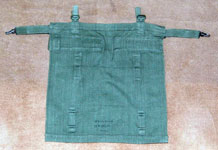
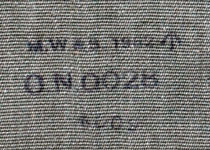 This 1962 example has green anodised fittings, rather than the bronzed finish of the 1959 example above.
This 1962 example has green anodised fittings, rather than the bronzed finish of the 1959 example above.


 These photographs are comparisons showing the difference in metal finishes on the fittings of 1959 and 1962 examples. The earlier example has a bronzed finished fittings, resembling sheradising, though this is process normally done on steel, rather than aluminium.
These photographs are comparisons showing the difference in metal finishes on the fittings of 1959 and 1962 examples. The earlier example has a bronzed finished fittings, resembling sheradising, though this is process normally done on steel, rather than aluminium.

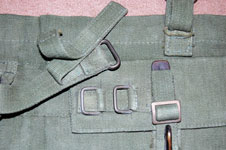
 The example from 1962, erroneously prefixed “ON”, rather than “CN” are the more familiar matt mid-green anodised form, here light in colour. Later forms were very dark green and some a very non-matt bilious green! In the photograph at right, the Carrier contents extend beyond the Carrier, such that the adjustable straps cannot be fastened to the pouch loops. It is also over-full and is probably secured using the Utility straps, not the QR fasteners. It is also upside-down - the links should be on the lower side of the Carrier. Had the Lightweight pick been carried, its head would be at the bottom of the Carrier. All examples in this section from the Rog Dennis Collection. Photos © Rog Dennis 2012. The photo at right is from APD 0384 The Queen's Commission (HMSO 1965).
The example from 1962, erroneously prefixed “ON”, rather than “CN” are the more familiar matt mid-green anodised form, here light in colour. Later forms were very dark green and some a very non-matt bilious green! In the photograph at right, the Carrier contents extend beyond the Carrier, such that the adjustable straps cannot be fastened to the pouch loops. It is also over-full and is probably secured using the Utility straps, not the QR fasteners. It is also upside-down - the links should be on the lower side of the Carrier. Had the Lightweight pick been carried, its head would be at the bottom of the Carrier. All examples in this section from the Rog Dennis Collection. Photos © Rog Dennis 2012. The photo at right is from APD 0384 The Queen's Commission (HMSO 1965).
Stores Ref. CN 8465-99-120-7156 CARRIER, CAPE, Modified [Issue 2]
Stores Ref. CN 8465-99-120-7156 CARRIER, CAPE [Issue 2]
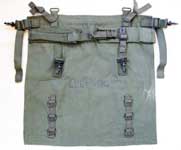
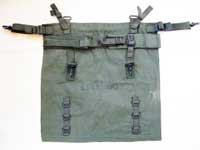
 The crimped tip on the semi-pocket closure strap was changed to an eyeletted form and a third pair of staples was added, to allow for greater variation in containing whatever was placed in the Carrier. When the old Cape / Groundsheet was superseded by a nylon Poncho, additional space resulted, which allowed for NBC clothing to be carried. The Utility straps could also be used for diameters greater than that normally accommodated. To an extent, a filled Cape carrier acted as a “shelf” on which the Rear pouches rested, but many soldiers elected to carry the Cape carrier above the “kidney pouches”, the belt hooks being attached around the rear yoke straps. From the Terry Hawker Collection. Photographs © Terry Hawker, 2012.
The crimped tip on the semi-pocket closure strap was changed to an eyeletted form and a third pair of staples was added, to allow for greater variation in containing whatever was placed in the Carrier. When the old Cape / Groundsheet was superseded by a nylon Poncho, additional space resulted, which allowed for NBC clothing to be carried. The Utility straps could also be used for diameters greater than that normally accommodated. To an extent, a filled Cape carrier acted as a “shelf” on which the Rear pouches rested, but many soldiers elected to carry the Cape carrier above the “kidney pouches”, the belt hooks being attached around the rear yoke straps. From the Terry Hawker Collection. Photographs © Terry Hawker, 2012.
Stores Ref. CN 1240-99-973-6959 CASE, BINOCULAR
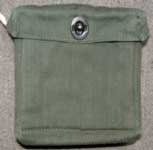

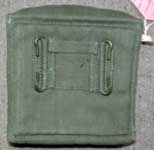 Not present in the 1959 LoC, or Fitting Instructions, the edition of 1965 lists and depicts (rather than illustrates!) additional “officer-type” additions to the Pattern. The 7 x 30 Binocular, prismatic, No. 2 was still a standard issue, so an un-stiffened, padded Case was designed. It was of rectangular cross-section, with none of the curves of the Patt. ’37 and ’44 designs and topped by a box-lid flap, closed by a turn button. The rear face had a pair of “C” hooks for attachment to the Belt, with a small webbing loop on the upper rear face, so that the Case could be threaded on the front straps of the Yoke, above an Ammunition pouch. This sealed Standard Pattern example is maker marked "M.W. & S." and dated 1963. From the Allen Prior Collection, Photos © Allen Prior, 2012.
Not present in the 1959 LoC, or Fitting Instructions, the edition of 1965 lists and depicts (rather than illustrates!) additional “officer-type” additions to the Pattern. The 7 x 30 Binocular, prismatic, No. 2 was still a standard issue, so an un-stiffened, padded Case was designed. It was of rectangular cross-section, with none of the curves of the Patt. ’37 and ’44 designs and topped by a box-lid flap, closed by a turn button. The rear face had a pair of “C” hooks for attachment to the Belt, with a small webbing loop on the upper rear face, so that the Case could be threaded on the front straps of the Yoke, above an Ammunition pouch. This sealed Standard Pattern example is maker marked "M.W. & S." and dated 1963. From the Allen Prior Collection, Photos © Allen Prior, 2012.
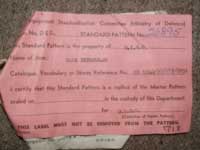 Details of the sealed Standard Pattern labels.
Details of the sealed Standard Pattern labels.

 Another example, from the Simon Howlett Collection. Photos © Simon Howlett, 2012.
Another example, from the Simon Howlett Collection. Photos © Simon Howlett, 2012.
Stores Ref. CN 8465-99-973-6960 CASE, COMPASS


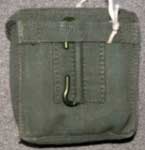 Introduced with the Binocular case, as its sequential code reveals, this was little different to the Pockets of earlier Patterns, though its box-lid flap was closed by a turn button. It was intended for the Compass, magnetic, marching, Mark 1. Only a single “C” hook was fitted, together with a transverse webbing loop, on the upper rear face, for carriage on a yoke strap. The sealed Standard Pattern example shown here is maker marked "M.E. Co." and dated 1963. From the Allen Prior Collection. Photos © Allen Prior 2012.
Introduced with the Binocular case, as its sequential code reveals, this was little different to the Pockets of earlier Patterns, though its box-lid flap was closed by a turn button. It was intended for the Compass, magnetic, marching, Mark 1. Only a single “C” hook was fitted, together with a transverse webbing loop, on the upper rear face, for carriage on a yoke strap. The sealed Standard Pattern example shown here is maker marked "M.E. Co." and dated 1963. From the Allen Prior Collection. Photos © Allen Prior 2012.
 Detail of the sealed Standard Pattern label.
Detail of the sealed Standard Pattern label.

 A second example, from the Simon Howlett Collection. Photos © Simon Howlett, 2012.
A second example, from the Simon Howlett Collection. Photos © Simon Howlett, 2012.
Stores Ref. CN 1095-99-973-6492 HOLSTER, PISTOL
NO PHOTOS EVER SEEN !!
This NSN formed part of the code list in the 1965 Fitting Instructions. It has not been found in any other official documentation and its form remains unknown. It ought not to be the drab Canadian CN / CG / B 7146 Holster, No. 2, Mk. 2 (later CN 1095-21-103-6512 in 1965 Patt. ’37 CCN listings). The Canadian example shown here is from the Keith Prince Collection. Photographs © Keith Prince 2012.



 By the same token, it cannot be the Canadian dark green Patt. ’51 HP Holster either, as this would also have had the Nation Code 21, though the U.K. did purchase large numbers of these. Does any reader have an example with the UK "99" country code?
By the same token, it cannot be the Canadian dark green Patt. ’51 HP Holster either, as this would also have had the Nation Code 21, though the U.K. did purchase large numbers of these. Does any reader have an example with the UK "99" country code?
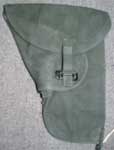

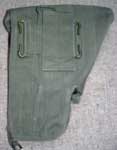 The .38-in. Pistol, revolver, No. 2 had largely fallen out of use, but the 9 mm Browning Hi-Power automatic was still in service. Although no Patt. ’58 Holster was listed in the 1959 Instructions, CN 0037 had been added by 1963, appearing in the 1965 edition of C.C.N., but as the N.S.N.. The design borrowed directly from the wartime Canadian pattern which, from the mid 50s, was manufactured in the U.K. in a softer form. That for Patt. ’58 utilised this latter design exactly, but in green webbing. One addition was a small metal D-ring at the muzzle end, on the barrel side of the holster. This was for the attachment of the tensioningstraps of the Cape carrier. It had a pair of “C” hooks on the rear face, a metal yoke loop between. A webbing belt loop was fitted below the loop, which the 1965 Instructions qualified as “…may be attached to a leg strap by means of a webbing loop sewn between the “C” hooks…”. Quite what provided the top support for such an arrangement was not made clear. No photograph has ever been noted of the Holster worn in this fashion. The sealed Standard Pattern example shown here is maker marked "M.E. Co." and dated 1963. From the Allen Prior Collection. Photos © Allen Prior 2012.
The .38-in. Pistol, revolver, No. 2 had largely fallen out of use, but the 9 mm Browning Hi-Power automatic was still in service. Although no Patt. ’58 Holster was listed in the 1959 Instructions, CN 0037 had been added by 1963, appearing in the 1965 edition of C.C.N., but as the N.S.N.. The design borrowed directly from the wartime Canadian pattern which, from the mid 50s, was manufactured in the U.K. in a softer form. That for Patt. ’58 utilised this latter design exactly, but in green webbing. One addition was a small metal D-ring at the muzzle end, on the barrel side of the holster. This was for the attachment of the tensioningstraps of the Cape carrier. It had a pair of “C” hooks on the rear face, a metal yoke loop between. A webbing belt loop was fitted below the loop, which the 1965 Instructions qualified as “…may be attached to a leg strap by means of a webbing loop sewn between the “C” hooks…”. Quite what provided the top support for such an arrangement was not made clear. No photograph has ever been noted of the Holster worn in this fashion. The sealed Standard Pattern example shown here is maker marked "M.E. Co." and dated 1963. From the Allen Prior Collection. Photos © Allen Prior 2012.

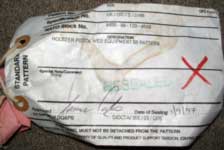 Details of the sealed Standard Pattern labels.
Details of the sealed Standard Pattern labels.
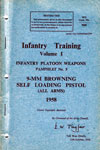
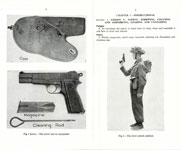 The illustration at right is from the 1958 small arms training pamphlet and clearly shows the stiff Canadian Holster still in use, not the British manufactured khaki version. From the John Bodsworth Collection.
The illustration at right is from the 1958 small arms training pamphlet and clearly shows the stiff Canadian Holster still in use, not the British manufactured khaki version. From the John Bodsworth Collection.


 Another example, from the Keith Prince Collection, photos © Keith Prince 2012.
Another example, from the Keith Prince Collection, photos © Keith Prince 2012.
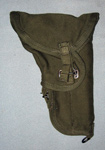


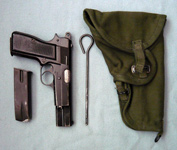 And yet another example, this one complete with its intended contents. The Holster is marked "O.W.L. 1984 | CT2?2/2183 | 1095-99-120-4509". O.W.L. is Ollard Westcombe Ltd., an Irish company. Included with it are the Pistol, 9 mm Automatic, L9A1; Rod, cleaning, small arms; and Magazine, cartridge, pistol. Provided to Karkee Web by a collector who wishes to remain unidentified. Photos © Karkee Web 2013.
And yet another example, this one complete with its intended contents. The Holster is marked "O.W.L. 1984 | CT2?2/2183 | 1095-99-120-4509". O.W.L. is Ollard Westcombe Ltd., an Irish company. Included with it are the Pistol, 9 mm Automatic, L9A1; Rod, cleaning, small arms; and Magazine, cartridge, pistol. Provided to Karkee Web by a collector who wishes to remain unidentified. Photos © Karkee Web 2013.
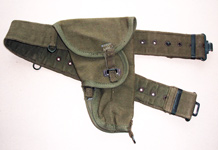
 This very late production Holster is marked "OWL '91 | 99-120-4509". From the Robert Mitchell Collection, photos © Robert Mitchell 2013.
This very late production Holster is marked "OWL '91 | 99-120-4509". From the Robert Mitchell Collection, photos © Robert Mitchell 2013.
Stores Ref. CN 0032 POUCH, REAR, MK. 1

 This was the third, re-used V.A.O.S. code, that had once been Bags, containing, that cryptic nomenclature being implicitly for bagpipes. The I Stores Design A had a single wide pouch at belt level. In Patt. ’58, this was divided into two, linked by a short strap in 2-inch wide webbing, making the “Pouch” a yoked pair. Each Pouch was of rectangular cross-section, deep enough to contain a rectangular Mess tin, with its long axis vertical. Each Pouch had a box-lid, with stiffening strips along the diagonal edge of the sides and closed by a QR fastener, with steel stiffened tabs. Under the underside of each lid was a fairlead in which the Utility straps could be stored. The rear faces of the Pouches were fitted out in a unique manner, utilising a very old component, the keyway, but here made in anodised aluminium. Each Pouch was fitted with a pair of standing staples, over which keyways on straps formed belt loops. At each outer edge, long straps were stitched that secured each pair of keyways over the staples. A short bight of webbing, stitched to the release strap, held a novel metal fitting, which served to give a finger grip, so that the straps could readily be withdrawn from the staples, allowing the Rear pouch to be discarded for Complete Equipment Fighting Order, always abbreviated to CEFO. Viewed from the rear, a white calico rectangle was stitched on the left-hand Pouch, where the soldier could write his name. The release straps were stiffened for most of their length with steel strip.
This was the third, re-used V.A.O.S. code, that had once been Bags, containing, that cryptic nomenclature being implicitly for bagpipes. The I Stores Design A had a single wide pouch at belt level. In Patt. ’58, this was divided into two, linked by a short strap in 2-inch wide webbing, making the “Pouch” a yoked pair. Each Pouch was of rectangular cross-section, deep enough to contain a rectangular Mess tin, with its long axis vertical. Each Pouch had a box-lid, with stiffening strips along the diagonal edge of the sides and closed by a QR fastener, with steel stiffened tabs. Under the underside of each lid was a fairlead in which the Utility straps could be stored. The rear faces of the Pouches were fitted out in a unique manner, utilising a very old component, the keyway, but here made in anodised aluminium. Each Pouch was fitted with a pair of standing staples, over which keyways on straps formed belt loops. At each outer edge, long straps were stitched that secured each pair of keyways over the staples. A short bight of webbing, stitched to the release strap, held a novel metal fitting, which served to give a finger grip, so that the straps could readily be withdrawn from the staples, allowing the Rear pouch to be discarded for Complete Equipment Fighting Order, always abbreviated to CEFO. Viewed from the rear, a white calico rectangle was stitched on the left-hand Pouch, where the soldier could write his name. The release straps were stiffened for most of their length with steel strip.

 A very good idea was then spoiled, because the bulk of the Pouch was above the Belt’s upper edge. It therefore sagged outwards and, as a “shelf” for the Pack to rest on, it therefore failed miserably. Even with the separated Mess tins, placed one in each Pouch, the stiffening effect was minimal.
A very good idea was then spoiled, because the bulk of the Pouch was above the Belt’s upper edge. It therefore sagged outwards and, as a “shelf” for the Pack to rest on, it therefore failed miserably. Even with the separated Mess tins, placed one in each Pouch, the stiffening effect was minimal.
They were colloquially termed by the plural “kidney pouches”, as opposed to the American term “butt pouch”, which was used for the similarly located item of M-1956 LCE. Typical British reserve meant we did not to refer to the Cap, Field Service by the U.S. anatomical term. Anyway, our butts were arses (today, the more decorous bums). The British Army even avoided its use in what was colloquially a “butt socket” (see below) – an add-on to Patt. ’58, dealt with below. All examples in this section from the Rog Dennis Collection. Photos © Rog Dennis 2012.
Stores Ref. CN 8465-99-973-6223 POUCHES, REAR [Issue 2]
Stores Ref. CN 8465-99-973-6223 POUCH, REAR [Issue 2]


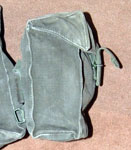 With their attitude towards “Form, Fit & Function”, it should be notted that, in UK-Control Reference List Reference Sequence, the changes from Issue 1 to 2 are ignored, so it equates CN 0032 to 8465-99-973-6222. However, the stiffening strips were removed from the sides of the box-lid flaps, so it was “modified”, though this additional term was reserved for the 3rd Issue. Both 1st and 2nd Issue Pouches were connected by a short length of 2-inch strapping, stitched across both Pouches and serving to cover the stitching attaching the keyway tabs to the Pouches. Note the ambivalence, first plural, then singular.
With their attitude towards “Form, Fit & Function”, it should be notted that, in UK-Control Reference List Reference Sequence, the changes from Issue 1 to 2 are ignored, so it equates CN 0032 to 8465-99-973-6222. However, the stiffening strips were removed from the sides of the box-lid flaps, so it was “modified”, though this additional term was reserved for the 3rd Issue. Both 1st and 2nd Issue Pouches were connected by a short length of 2-inch strapping, stitched across both Pouches and serving to cover the stitching attaching the keyway tabs to the Pouches. Note the ambivalence, first plural, then singular.
From the Rog Dennis Collection. Photos © Rog Dennis 2012.
Stores Ref. CN 8465-99-120-7158 POUCHES, REAR, Modified [Issue 3]
Stores Ref. CN 8465-99-120-7158 POUCH, REAR [Issue 3]

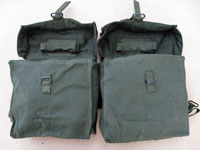
 The Pouch, rear in Section CN, of the 1965 C.C.N., had unaccountably become pluralised and, briefly, acquired the accurate term of “Modified”. The problem of sagging was cured very effectively, by the addition of another pair of staples, set close together, higher up the rear face of each Pouch. A secondary strap was stitched to the release strap at right angles, orientated vertically upwards. Its end stiffened with steel strip, it was flexible at the junction, so that it could be bent round horizontally to fit through the extra staples, behind and between which the rear straps of the Yoke were trapped. The sides of the box-lid flaps remained un-stiffened and the central QR fastener tended to pull down in the middle, so that the outer ends of the box-lid popped upwards over a filled pocket – not quite so successful for weather-proofing! A pair of QR fasteners would have been much better, from Day One. A second linking strip was added to connect the upper vertical edges of the Pouches. In between the staples for the keyways, an extra one was added on each Pouch. These were close to the inner staples, but not in-line with the keyway strap. The reason for this is not clear, other than as a “guide” for the long stiffened securing tab. From Terry Hawker Collection. Photograph © Terry Hawker, 2012.
The Pouch, rear in Section CN, of the 1965 C.C.N., had unaccountably become pluralised and, briefly, acquired the accurate term of “Modified”. The problem of sagging was cured very effectively, by the addition of another pair of staples, set close together, higher up the rear face of each Pouch. A secondary strap was stitched to the release strap at right angles, orientated vertically upwards. Its end stiffened with steel strip, it was flexible at the junction, so that it could be bent round horizontally to fit through the extra staples, behind and between which the rear straps of the Yoke were trapped. The sides of the box-lid flaps remained un-stiffened and the central QR fastener tended to pull down in the middle, so that the outer ends of the box-lid popped upwards over a filled pocket – not quite so successful for weather-proofing! A pair of QR fasteners would have been much better, from Day One. A second linking strip was added to connect the upper vertical edges of the Pouches. In between the staples for the keyways, an extra one was added on each Pouch. These were close to the inner staples, but not in-line with the keyway strap. The reason for this is not clear, other than as a “guide” for the long stiffened securing tab. From Terry Hawker Collection. Photograph © Terry Hawker, 2012.

 This shows the layout of the securing straps, when withdrawn from the staples, the second (upper) web linking piece and the extra staples for the inner keyways. From the Rog Dennis Collection. Photos © Rog Dennis 2012.
This shows the layout of the securing straps, when withdrawn from the staples, the second (upper) web linking piece and the extra staples for the inner keyways. From the Rog Dennis Collection. Photos © Rog Dennis 2012.
Rog Dennis 2012